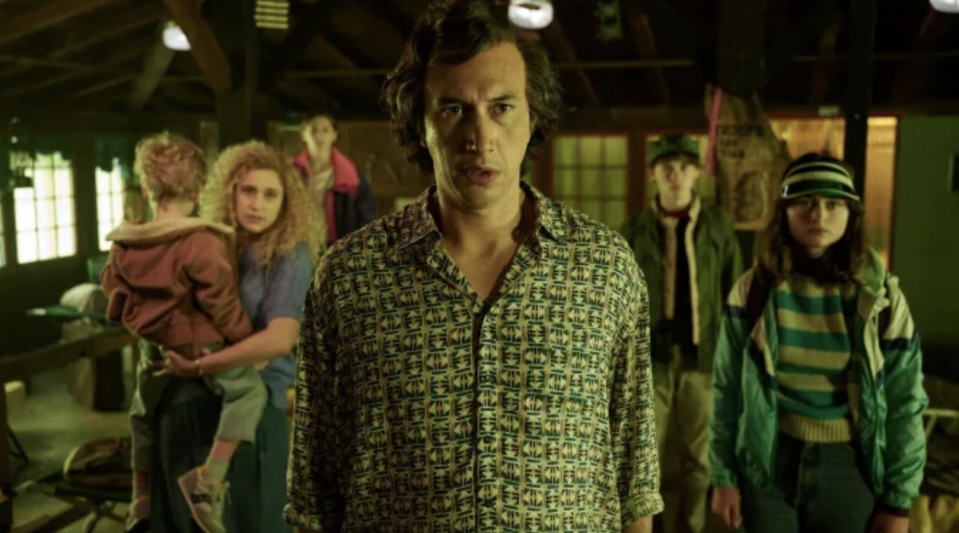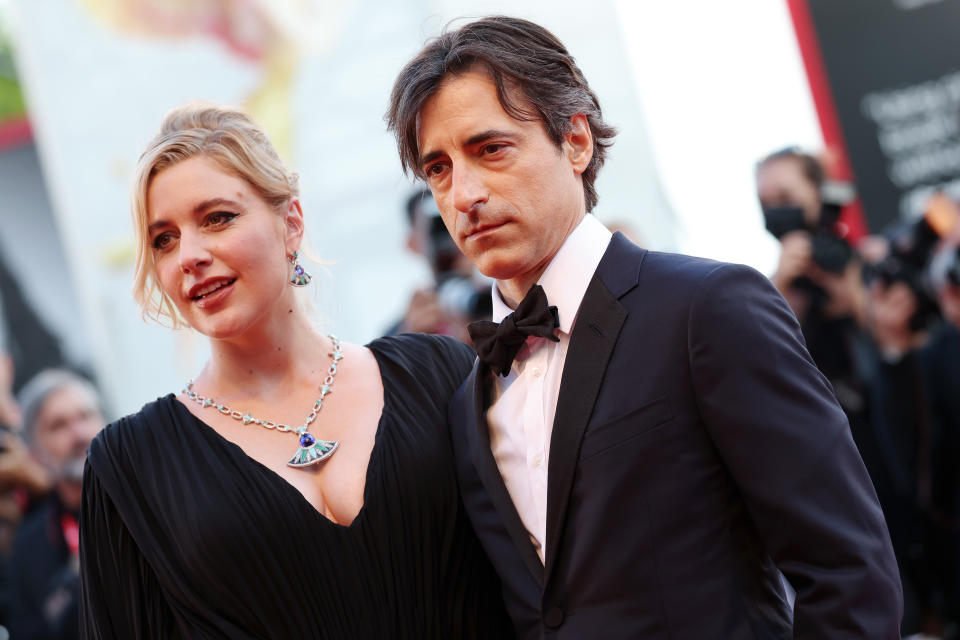Noah Baumbach on His Ambitious ‘White Noise’ Budget and What the Film Says About America Today

- Oops!Something went wrong.Please try again later.
- Oops!Something went wrong.Please try again later.
- Oops!Something went wrong.Please try again later.
- Oops!Something went wrong.Please try again later.
Noah Baumbach’s adaptation of Don DeLillo’s “White Noise” takes place in 1984 and tackles that era of America through the prism of the movies made at that time. Yet its satiric look at the way academia reduces all culture to cold analysis has a certain modern-day resonance.
“We all go through this with the internet,” Baumbach said in a recent phone interview with IndieWire. “I’ve watched YouTube a lot. You can see all these different things of totally different value. You can look at the horrors of the world or old commercials, and it all suddenly takes on some kind of equal value when you’re looking at it that way. Bo Burnham even sings about it.”
More from IndieWire
It might seem like a stretch to insert the themes of DeLillo’s oddball novel, which was so rooted in its time, into a 21st-century context. But the material invites big swings, including Baumbach’s own efforts to transform a book that for years has been considered unfilmable into a beguiling movie odyssey as strange and unclassifiable as its source.
In his first extended interview following the movie’s premiere in Venice, Baumbach was still figuring out how to talk it through. “There’s a lot to say about it,” he said. “I started doing this as an exercise to see if I felt like it could be a movie. The more I got into it, the more I got excited about things that I could do that you couldn’t do in a book.”
Nevertheless, “White Noise” remains faithful to DeLillo’s vision in ways that may have been inconceivable to any other filmmaker. The wandering story follows egghead professor Jack Gladney (Adam Driver in his fifth Baumbach collaboration) at the fictional College-on-the-Hill, and his neurotic, pill-popping wife, Babette (Greta Gerwig). As a “Hitler studies” professor, Jack relishes an insular existence of aimless classroom analysis. That routine gets disrupted a few times over, first by an “airborne toxic event,” and then by a drug-dealing conspiracy too bizarre to summarize here. “It’s both absurd and funny on the face of it,” Baumbach said. “I was struck reading it again feeling like it could’ve been written at any point in time.”
Previous attempts to adapt “White Noise” by James L. Brooks and Barry Sonnenfeld went nowhere, and the director of grounded dramedies like “Marriage Story” and “Greenberg” might not seem like the obvious fit to figure it out. Baumbach, however, was drawn to the way the novel merged analytical thinking with otherworldly twists, because the latter provided a template for the former. “The story is about a culture that is saturated by media,” he said. “Movies and entertainment being a big part of that. I felt like there could be a cinematic language we’re all familiar with that I could use to tell this story.”
The movie references are strewn across “White Noise” with the frenzy of a Pollock painting as it transforms existential dread into an extended punchline. Equal parts Steven Spielberg and Jean-Luc Godard, Baumbach’s “White Noise” oscillates from liberal college family dramedy to a dreamlike sci-fi disaster movie and back again. Cerebral and escapist, it’s unlike anything the filmmaker has made before. “That was exciting for me,” Baumbach said. “I think of this movie as floating somewhere above reality. It’s close but not entirely with its feet on the ground.”
One way that movie may have seemed unreal was its scale. Reports of the Netflix production having a budget that stretched past $80 – 100 million has led to much speculation about where that money was going. Some of that is evident on the screen, from an explosive train crash to a car chase through the woods that takes more than few surprising twists and the scariest CGI cloud this side of “Nope.” Baumbach also shot the movie on 35mm anamorphic film, which isn’t exactly the most cost-effective approach.

Netflix
“Netflix was great and gave us the support we needed to make the movie,” Baumbach said. “The book has this airborne toxic event, which is a big spectacle, and it becomes a big movie as a result.” He added that the streamer, which produced Baumbach’s last two movies, knew what it was getting into. “You begin by budgeting the script you’ve written, then you sort of look at the numbers and think about the practical application, which is no different from how you’d do any movie,” he said. “I wasn’t thinking about scope except to the degree that it tells the story. I wasn’t interested in doing the smaller version of that.”
And then there was the pandemic of it all. With COVID precautions adding around 20 percent to the costs of most film productions, and outbreaks among the crew slowing down the shooting schedule, Baumbach said that some circumstances were beyond his control. “When I look back on it, we had amazing support, and it was incredible we could do it,” he said. “But when I see photos of myself directing in a mask, I’m kind of amazed that it was possible at all.”
That perception applies more generally to the challenge of expanding “White Noise” from page to screen. The movie starts in familiar Baumbach territory, with a well-to-do family struggling through interpersonal dramas, but it takes a sharp detour into “War of the Worlds” by way of “Weekend” as it tracks the experience of a controlled world collapsing in the face of the darkness its characters would prefer not to discuss.
“It’s telling this story of how, in our attempts not to deal with our own mortality, to really acknowledge death in a serious way in our culture, we somehow sublimated death into our entertainment,” Baumbach said. Not for nothing does the movie begin with a rival professor, Murray Suskind (Don Cheadle), lecturing on the poetic significance of car crashes. In a broader sense, “White Noise” interrogates the myth of ’80s America — a period defined by the AIDS and homeless crises even as popular culture ignored them through spectacles. “By cloaking yourself in death and horror, you’re somehow protecting yourself from real death and horror,” Baumbach said.
A hilarious showdown between Driver and Cheadle, where the two teachers compete over whether Hitler or Elvis serves as a more involving object of study, stands out. “You’re teaching Elvis, you’re teaching Hitler, you lecture on their relationships with their mothers, and they become of sort of equal value for the moment when of course they’re not,” Baumbach said. “Everything gets leveled out in our culture.”
The bubble of highbrow college life rang true for Baumbach on a few levels. “It reminded me of a lot of experiences, classes, and the culture of Vassar when I was there in the late ‘80s and early ‘90s,” he said, noting that his brother, Columbia University professor Nico Baumbach, keeps him abreast of modern academic developments. “From what I understand, things in academia haven’t changed dramatically,” Baumbach said.
“White Noise” expands beyond that milieu in its ambitious second act. When Jack and his family drive into traffic in a cluttered attempt to flee the airborne event, “White Noise” forces Baumbach into uncharted terrain: Yes, the traffic pileup recalls Godard’s “Weekend,” but there are large crowds, special effects, and action sequences — most of which were done practically — that Baumbach’s usual dialogue-driven storytelling never called for. “They’re all kind of aspects of moviemaking that have been interesting to me, but I haven’t written scripts that have called for it,” he said.

Getty Images
The material also pushed longtime collaborator Driver to try something different. While he shed pounds for Martin Scorsese’s “Silence,” the actor put on weight and wore a wig with a receding hairline to inhabit the middle-aged Jack in “White Noise.” Driver said at a Venice press conference that he embraced the physical strangeness of the role. “There are moments of big theatricality,” he said. “The boundaries of this movie were wider.” Baumbach told IndieWire that Driver’s secret to weight gain was drinking a lot of beer. “At least that’s what he told me,” Baumbach said. “I’m always amazed at what Adam can do, but also what I can give him. I would normally say, let’s not do wigs, I don’t want to get involved with all of that. But with this movie, I felt like there was an aspect of performance inherent in the whole thing of it so that the actors should have that as well.”
As for Gerwig: Baumbach first collaborated with the actress when he cast her in “Greenberg” years before they married. Now they’ve made three movies together and have a young child, but “White Noise” was their first time working together since 2015’s “Mistress America.” Though Gerwig recently finished directing her Warner Bros. production of “Barbie” from a script she co-wrote with Baumbach, he was eager to keep her in front of the camera as well. “I’d love to do it again soon,” he said. “It was very easy to fall right back into it.” (At Venice, Gerwig said the role was “both emotionally and intellectually exciting.”)
Baumbach beamed about a bedroom sequence in which Gerwig’s character delivers a prolonged monologue and reveals the secret she’s kept from her husband for months. The scene drags on for minutes and enters a surreal plane that builds on its literary roots through heightened wordplay. “I feel like I’ve never seen an actor do something quite like that,” Baumbach said. “I marveled at her when I watched that scene unfold. It’s a singular performance.”
The real scene-stealer of “White Noise” is the entire ensemble, which gathers for a memorable dance number at the supermarket over the credits set to a new song by LCD Soundsystem. Baumbach employed choreographer David Neumann, who also advised on movement in “Marriage Story” as well as other “White Noise” scenes that don’t involve dance. Needless to say, the dance in “White Noise” is the final adventurous flourish in a movie loaded with them from start to finish. “It’s almost like a happiness pill,” Baumbach said. “I felt like it was both a dance sequence and a kind of journey through life and community in this space.”
The giddiness of the finale is a kind of victory lap for Baumbach: Not only did he crack “White Noise” as a movie, but he found a way to make it fun, too. With “Barbie” on the horizon, could this serious-minded auteur actually have commercial ambitions? Anyone who digs through Baumbach’s filmography will recall a writing credit from 10 years ago that proves he’s not exclusive to the arthouse domain. “If you really look, you know I’ve really done it all in ‘Madagascar 3,’” Baumbach said, and laughed. “These things are not as alien to me as they might appear from my work.”
“White Noise” opens the 60th New York Film Festival this week. Netflix releases it in theaters on Friday, November 25 and it starts streaming on the platform on Friday, December 30.
Best of IndieWire
New Movies: Release Calendar for September 30, Plus Where to Watch the Latest Films
Martin Scorsese's Favorite Movies: 50 Films the Director Wants You to See
Sign up for Indiewire's Newsletter. For the latest news, follow us on Facebook, Twitter, and Instagram.

